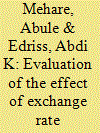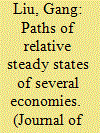| Srl | Item |
| 1 |
ID:
122454


|
|
|
|
|
| Publication |
2013.
|
| Summary/Abstract |
Research was conducted to find out the effects of exchange rate variability, terms of trade, competitiveness and gross domestic product on the dominant export crop of Ethiopia, coffee. This study employs annual time series data (1992-2010) and uses the autoregressive distributive lag (ARDL) model augmented by the Wald test. The results reveal that exchange rate variability has a negative effect on the export of coffee in the short run, but is insignificant in the long run. This implies that, over time, exchange rate changes in the country have been favouring the export performance of coffee. Regardless of exchange rate variability, the competitiveness of the country, explained by real effective exchange rates, improved, but the price of coffee did not increase relative to the price of imports, which has resulted in deteriorating terms of trade. To improve the worsening terms of trade and benefit from policy changes, export diversification and value addition are possible solutions the country should focus on.
|
|
|
|
|
|
|
|
|
|
|
|
|
|
|
|
| 2 |
ID:
089973


|
|
|
|
|
| Publication |
2009.
|
| Summary/Abstract |
In this paper, an economy means a national economy; an economy's relative steady state means an economy's steady state of per-capita output relative to the mean of those of a broad set of economies. This paper provides a method used not only to get the path of an economy's relative steady state, but also to assess whether an economy's relative steady state changed between two given periods and whether an economy's relative steady state in a given period differed from another economy's in the same or a different given period. This paper also shows the paths of relative steady states of six economies (China, India, South Korea, Taiwan, Japan and USA) using the estimates of their relative steady states in four successive periods (1960s, 1970s, 1980s and 1990s). A comparison of the paths gives valuable information.
|
|
|
|
|
|
|
|
|
|
|
|
|
|
|
|